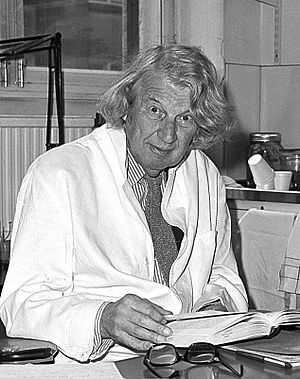John Zachary Young facts for kids
Quick facts for kids
|
|
|---|---|

John Zachary Young in 1978
|
|
| Born | 18 March 1907 |
| Died | 4 July 1997 (Age 90) |
| Nationality | British |
| Alma mater | Magdalen College, University of Oxford |
| Known for | Research on the giant axon of the squid |
| Awards | Royal Medal (1967) Linnean Medal (1973) |
| Scientific career | |
| Fields | Zoology, Anatomy, Physiology |
| Institutions | University College London, University of Oxford |
| Influenced | Semir Zeki, Humberto Maturana |
John Zachary Young (born March 18, 1907 – died July 4, 1997) was a famous British scientist. People often called him "JZ" or "JZY". He studied animals (zoology) and how the brain and nerves work (neurophysiology). Many people thought he was one of the most important biologists of the 20th century.
Contents
About J.Z. Young's Life
John Zachary Young went to school at Marlborough College. In 1928, he earned a top degree in zoology from Magdalen College, Oxford. This showed he was very good at studying animals.
In 1945, he became a member of the Royal Society, which is a group for important scientists. He also became a professor at University College London. He taught there until 1974. After that, he was given the title of Professor Emeritus, which means he was a respected retired professor.
Young received many awards for his work. He won the Linnean Medal in 1973 for his studies in zoology. The University of Bath gave him an honorary science degree in 1974. Today, a special teaching position at University College London is named the J. Z. Young Chair in his honor.
For many years, Young spent his summers doing experiments at a research center in Naples, Italy. The city even made him an honorary citizen in 1991.
Discoveries About Nerves and the Brain
Most of Young's science work was about the nervous system. This is the system in our bodies that sends messages, like how our brain talks to our muscles.
The Giant Squid Nerve
One of his most famous discoveries was the squid giant axon. This is a very large nerve fiber found in squids. Because it was so big, scientists could study how nerve signals travel. Young's work in the 1930s helped other scientists, like Sir Andrew Huxley and Sir Alan Hodgkin, understand how nerves send signals. They later won a Nobel prize for their work.
Helping Injured Nerves
During World War II, many soldiers had nerve injuries. Young used his knowledge of animals and how nerves regrow to help. He set up a special team at the University of Oxford to study how nerves in mammals (like humans) could heal.
His team looked for ways to make damaged nerves grow back faster. Working with another scientist named Peter Medawar, Young found a way to "glue" small nerves back together using a special plasma. This method was later changed and used in real surgeries to help people.
Studying the Brain
After the war, Young became very interested in the brain. He talked and wrote to the famous mathematician Alan Turing about brain cells, how we remember things, how we recognize patterns, and how living things develop.
In 1950, Young gave a series of radio talks for the BBC. These talks were called Doubt and Certainty in Science. He explained to the public how the brain works and how scientists were trying to understand it better.
Young is also well-known for his two textbooks: The Life of Vertebrates and The Life of Mammals. These books taught many students about different animals. He also led the Marine Biological Association for ten years, from 1976 to 1986.
Young's Family Life
John Young was born in a place called Mangotsfield, near Bristol. When he started working at University College London, he moved to London. Later, after he retired in 1974, he moved to a house in Brill, a village in Buckinghamshire. Even in retirement, he kept working at the research center in Naples and at Oxford University. He also continued to publish scientific papers.
Young was married twice. First, to Phyllis Heaney, who was a painter. They had two children, Simon and Cordelia. After Phyllis passed away, he married Raymonde Parsons, who was also an artist. They had one child, Kate.

